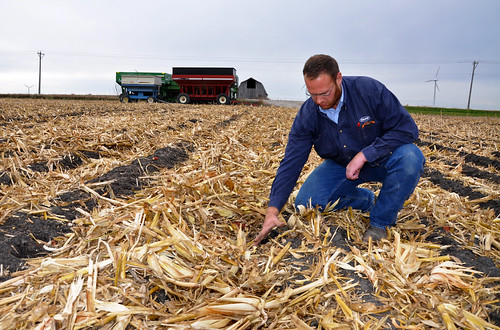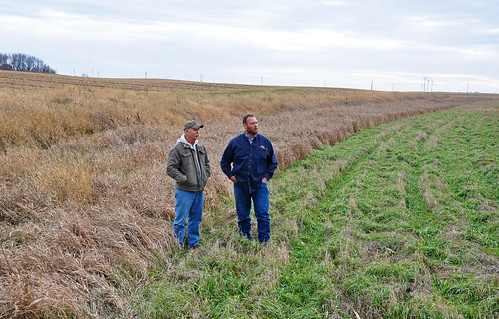
The U.S. Department of Agriculture is helping Iraq War veteran Adam Boge improve technology and other efficiencies in his new farming operation, allowing the Ventura farmer to prepare for long-term success in the first full year on his own.
Boge enlisted in the Army directly out of high school. After his initial military service, he attended Iowa State University for Ag Systems Technology and Mechanical Engineering. College was interrupted, however, by his Iraq deployment. Boge represented the Army National Guard’s 1133rd Transportation Company out of Mason City for 15 months throughout 2003 and 2004 in Operation Iraqi Freedom.
Upon his return to the United States, he continued his education and also began taking “hired hand” positions on farms near Ames. “That’s when I started to think more seriously about developing a business plan to someday take over a farm,” he said. “Unless you’re born into it, though, it is really difficult to capture farming ground.”

A Return to Iowa
Back in Iowa and still yearning to farm, Boge learned that his respected neighbor Dave Rosendahl could soon be retiring from farming. He quickly put together a proposal and approached Rosendahl about it. “That’s when things started to come together for me,” said Boge.
While Rosendahl discussed the proposal with his family, Boge took an opportunity to learn more about Rosendahl’s management system. He helped a neighbor through the 2012 crop season, farming corn and soybeans in the Prairie Pothole region of Cerro Gordo County.
Prior to the 2013 planting season, Boge and Rosendahl formed a handshake agreement to crop share for three to five years, eventually handing over all day-to-day farming activities to Boge. However, that timeframe was quickly moved up. Boge said, “During the 2013 harvest Dave and I passed through the last bit of corn and Dave looked at me and said, ‘Here are the reigns. I’m complete. I’m satisfied.’”
Boge says his plan was to take over a couple hundred acres, but Rosendahl was ready to give up all 980 acres covering nine farms and five landlords.

Conservation
As primary operator of the ground, Boge was eligible to apply for local, state and federal conservation programs. Coincidentally, the 2014 Farm Bill provides benefits for veterans like Boge who are beginning farmers.
Boge visited the USDA Service Center in Mason City and spoke with Tony Moore, district conservationist with USDA’s Natural Resources Conservation Service (NRCS), about conservation planning and programs for his new operation. Moore recommended Boge apply for the Conservation Stewardship Program (CSP).
When beginning veteran farmers apply and receive eligibility for CSP, they are given priority status by NRCS to receive funding. Boge became CSP eligible on all 980 acres.
He credits Rosendahl for his CSP eligibility, considering Rosendahl implemented many conservation practices on the land throughout the years, including filter strips along drainage ways, natural wetlands for wildlife habitat, and years of soil saving with ridge till.
“I want to continue what Dave was doing,” said Boge. “The way Dave farmed and took care of his land, I see no reason to change it. There is ground here that hasn’t been ripped in 30 years. There is an unbelievable amount of soil tilth out there created by earthworm activity.”
Moving forward, Boge is implementing an enhancement bundle he chose through CSP, which include widening stream buffers, and improving nutrient and pesticide application techniques. “A lot of it is updating the technology and making the operation more efficient,” he said. “Updated GPS will ensure I don’t over-apply nutrients and pesticides. CSP is allowing me to take the operation to another level.”

Boge says he’s appreciative of USDA support for veterans trying to get a start in agriculture. “You spend time in a combat environment and come back, you think there isn’t much you shouldn’t be able to achieve, but you hit roadblocks and it gets discouraging after a while,” he said. “As veterans, we don’t ask for much from our country. I wanted to achieve everything on my own, but when you sit down and look at the bottom dollar, maybe I needed a little help. If CSP is the way to get it, then that’s OK.”
For more information about conservation plans and programs, visit your local USDA Service Center, or go online to www.nrcs.usda.gov.
Download a printed copy of this story, here.
